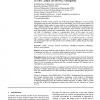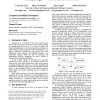901 search results - page 8 / 181 » Minimum power configuration in wireless sensor networks |
IJAHUC
2007
13 years 8 months ago
2007
: In wireless sensor networks, one of the main design challenges is to save severely constrained energy resources and obtain a long system lifetime. Low cost of sensors enables us ...
SAMOS
2007
Springer
14 years 2 months ago
2007
Springer
For most applications in wireless sensor networks (WSNs), it is often assumed that the deployment of sensor nodes is unmanaged and random, so the density of local node may vary thr...
MOBIHOC
2000
ACM
14 years 5 days ago
2000
ACM
AbstractDeveloping wireless sensor networks can enable information gathering, information processing and reliable monitoring of a variety of environments for both civil and militar...
CONEXT
2008
ACM
13 years 9 months ago
2008
ACM
One of the fundamental problems in the wireless sensor networks is the coverage problem. The coverage problem fundamentally address the quality of service (surveillance or monitor...
SENSYS
2004
ACM
14 years 2 months ago
2004
ACM
bstract: Power - Time Optimal Algorithm for Computing FFT over Sensor Networks Categories and Subject Descriptors C.2.1 [Network Architecture and Design] Wireless Communication, Di...


